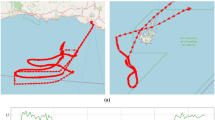Abstract
We describe a method, radio-acoustic-positioning (RAP), for continuously monitoring the movements and behavior of large marine animals. An ultrasonic transmitter on the animal can be localized with high spatial accuracy (2 to 10 m) within an area of 1 km2, based on when the same pulse arrives at three hydrophones on sonobuoys aligned in a triangular array. Radio transceivers communicate with the base station, where the x and y coordinates of the subject are calculated using hyperbolic equations. The base station plots the individual's position and displays information from the tag's sensors in real time on a computer monitor before saving the data on a disk. The base station must be situated either on land or on a vessel within the reception range of the three buoys. We used a RAP system to monitor the movements and behavior of white sharks (Carcharodon carcharias) near the elephant seal rookery at Año Nuevo Island in central California. This type of system is an ideal tool to study the predatory behavior of the white shark because individuals patrol for seal prey within a zone <1300 m from shore. We describe the operation of the system, including acoustic triangulation, range of detection and positioning, data acquisition and analysis, and positional accuracy. We illustrate the implementation of the method and its advantages and disadvantages by describing an ongoing study of white shark hunting-behavior. Sample data from this study are presented to illustrate specific points. We describe the movements of five sharks within the receiving range and their behavior relative to each other. The RAP system is compared to other complementary tracking methods. We conclude that this system has great potential for monitoring the movements and behavior of large marine animals within a relatively small zone, where feeding or reproduction takes place.
Similar content being viewed by others
Author information
Authors and Affiliations
Additional information
Received: 21 October 1999 / Accepted: 30 June 2000
Rights and permissions
About this article
Cite this article
Klimley, A., Le Boeuf, B., Cantara, K. et al. Radio-acoustic positioning as a tool for studying site-specific behavior of the white shark and other large marine species. Marine Biology 138, 429–446 (2001). https://doi.org/10.1007/s002270000394
Issue Date:
DOI: https://doi.org/10.1007/s002270000394




